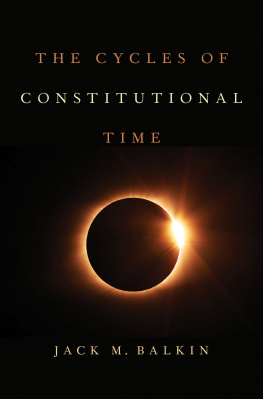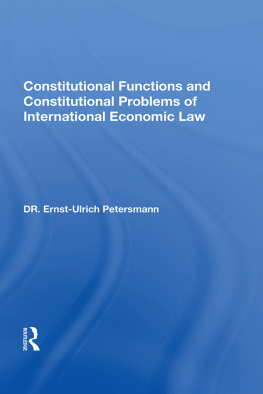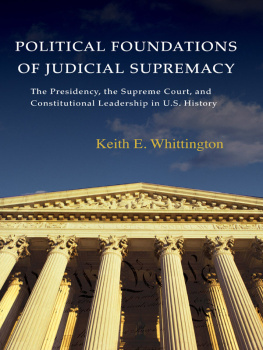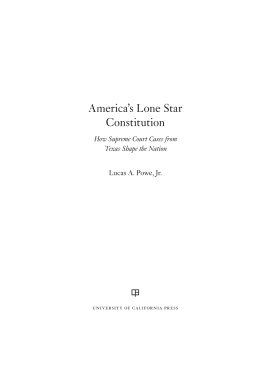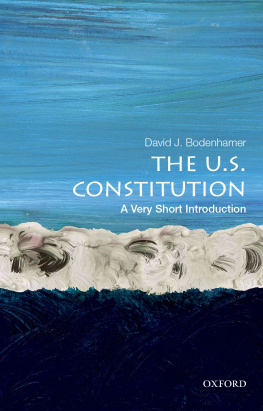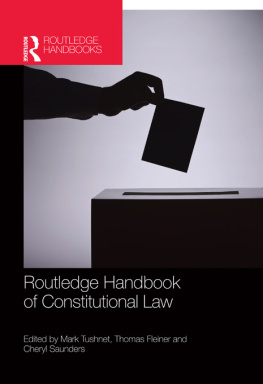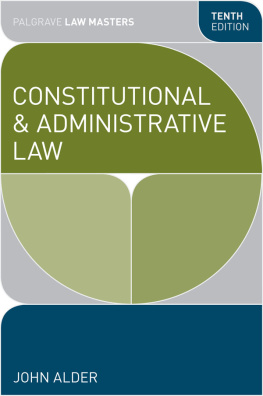
Table of Contents
Guide
Pages
Also by Jack Fruchtman
Author
The Supreme Court: Rulings on American Government and Society
The Political Philosophy of Thomas Paine.
Atlantic Cousins: Benjamin Franklin and His Visionary Circle
Thomas Paine: Apostle of Freedom.
Thomas Paine and the Religion of Nature
The Apocalyptic Politics of Richard Price and Joseph Priestley
Editor
Common Sense, Rights of Man, and Other Essential Writings of Thomas Paine
A Life in Jewish Education: Essays in Honor of Louis L. Kaplan
Britain in the Hanoverian Age, 17141837: An Encyclopedia (co-editor)
An Eye-Witness Account of the French Revolution by Helen Maria Williams: Letters Containing a Sketch of the Politics of France
American Constitutional History
A Brief Introduction
Jack Fruchtman
This edition first published 2016
2016 John Wiley & Sons, Inc.
Registered Office
John Wiley & Sons, Ltd, The Atrium, Southern Gate, Chichester, West Sussex, PO19 8SQ, UK
Editorial Offices
350 Main Street, Malden, MA 02148-5020, USA
9600 Garsington Road, Oxford, OX4 2DQ, UK
The Atrium, Southern Gate, Chichester, West Sussex, PO19 8SQ, UK
For details of our global editorial offices, for customer services, and for information about how to apply for permission to reuse the copyright material in this book please see our website at www.wiley.com/wiley-blackwell.
The right of Jack Fruchtman to be identified as the author of this work has been asserted in accordance with the UK Copyright, Designs and Patents Act 1988.
All rights reserved. No part of this publication may be reproduced, stored in a retrieval system, or transmitted, in any form or by any means, electronic, mechanical, photocopying, recording or otherwise, except as permitted by the UK Copyright, Designs and Patents Act 1988, without the prior permission of the publisher.
Wiley also publishes its books in a variety of electronic formats. Some content that appears in print may not be available in electronic books.
Designations used by companies to distinguish their products are often claimed as trademarks. All brand names and product names used in this book are trade names, service marks, trademarks or registered trademarks of their respective owners. The publisher is not associated with any product or vendor mentioned in this book.
Limit of Liability/Disclaimer of Warranty: While the publisher and author have used their best efforts in preparing this book, they make no representations or warranties with respect to the accuracy or completeness of the contents of this book and specifically disclaim any implied warranties of merchantability or fitness for a particular purpose. It is sold on the understanding that the publisher is not engaged in rendering professional services and neither the publisher nor the author shall be liable for damages arising herefrom. If professional advice or other expert assistance is required, the services of a competent professional should be sought.
Library of Congress Cataloging-in-Publication data applied for
9781119141723 (hardback)
9781119141754 (paperback)
A catalogue record for this book is available from the British Library.
Cover image: Arda Guldogan/Getty
For Clara, Juliette, Sophia, Elsa, and Nicholas
Acknowledgments
Five political scientists and historians have inspired the organization of this book as revealing how the Constitution evolved through a series of republics. None of them have developed the idea of six republics. Bruce Ackerman, who is also a law professor, Stephen Skowronek, Theodore Lowi, Richard Cortner, and Michael Lind have all argued that while the Constitution is virtually unchanged since the ratification of the Bill of Rights in 1791, the document did indeed evolve through distinct periods. I am grateful to them for their observations and analyses, which have informed my own thinking but which also differs from theirs in many respects.
I wish to thank Dean Terry A. Cooney of the College of Liberal Arts and Provost Timothy Chandler, both of Towson University, for granting me a year-long sabbatical to work on and complete the manuscript. Discussions about American constitutional history have been invaluable to me as I formulated my thinking about the Constitutions evolution. In particular, I thank my colleagues Cynthia Cates, H. George Hahn, and Richard Vatz for raising questions and stimulating debate about the Constitution. In addition, I will always be indebted to John Pocock and J. Woodford Howard Jr. of the Johns Hopkins University whose work has long been a model to all who write history. In addition, I would like to recognize Stephens Broening, Herbert Goldman, Xerxes Mehta, and Judge Allen Schwait for engaging me in conversation and debate over the years about the nature and meaning of the Constitution.
I also appreciate the support that John Wiley & Sons have given me, especially my editor Peter Coveney who supported this project and Jan East who edited it. I am grateful to the three anonymous reviewers of my manuscript, whose observations helped make the book more accessible to readers. Finally, I could not have completed this work without the support and devotion of my wife, JoAnn, whose lifelong companionship has been invaluable. All errors are of course my own.
Prologue
The United States Constitution is the oldest, continuous, national republican document in existence today. It was not the first. Republics, or mixed regimes as they are also known, existed long before the Americans crafted theirs in 1787. Most did not last very long. In the ancient world, the Roman republic collapsed when it degenerated into empire. During the Renaissance, the Florentine republic in Italy survived a mere 14 years, from 1498 to 1512. It dissolved when the powerful Medici family, which had once ruled Florence, re-established a dictatorship. According to the classical republican tradition, republics were fragile political organizations, because the critical balance between the various branches of government could easily crumble when one or two dominated the others. The Americans modeled their constitution on the British government with its one-person executive and two-part legislature. The British failed to create a true republic, because a hereditary monarch led the executive branch and hereditary aristocrats controlled the upper house, the unelected House of Lords. Large landowners controlled the House of Commons and only a few men possessed the right to vote. Americans believed that after separating from the British Empire, they could create a true republican structure where citizens participated in decision-making and enjoyed peaceful transitions of power.
The Constitution created a democratic republic, not a democracy. In a democracy, citizens vote directly on government policies, while in a republic, they elect representatives to develop policies on their behalf. Vestiges of democracy remain in America. They include the New England town meeting when residents directly vote on issues, such as whether the town should purchase a new police cruiser. The ballot initiative, also called the referendum, exists in over 40 states, allowing voters to make specific policies, such as whether a state should repeal its capital punishment law. Most laws in the United States today, however, are passed by representatives elected by the citizens. This system comprises the republic.
Next page



